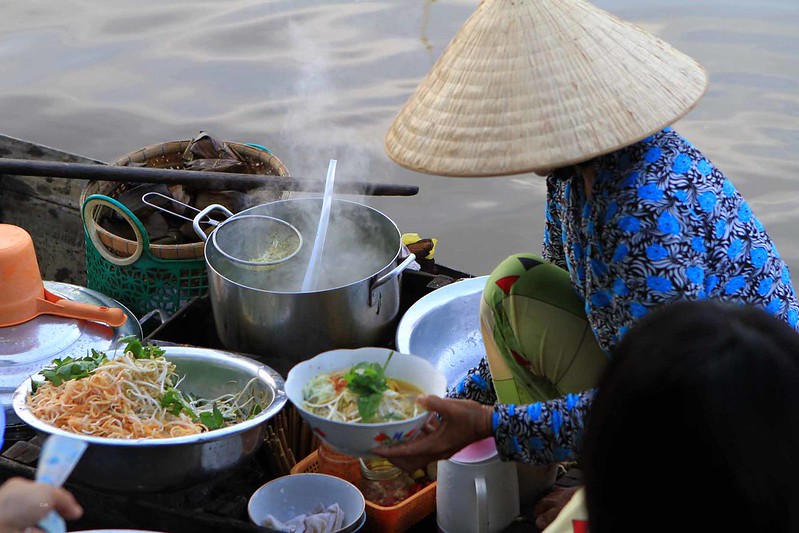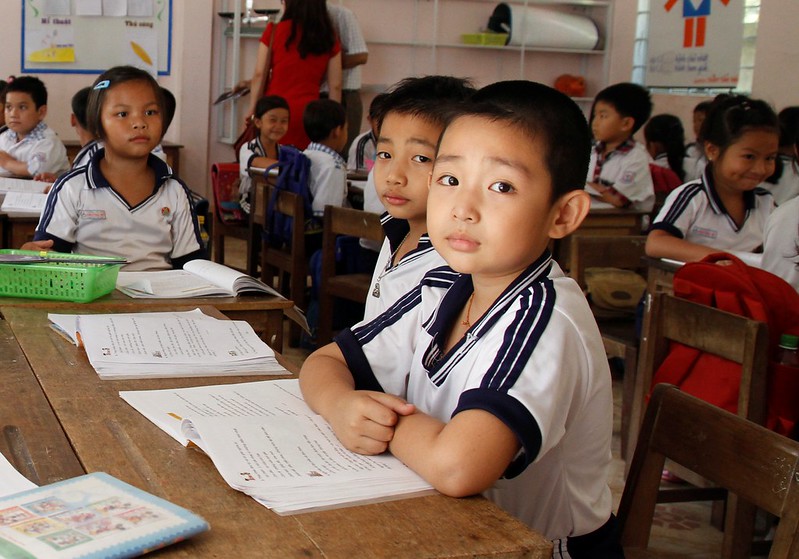Chuyển thay đổi từ tài chính kế hoạch hóa triệu tập sang kinh tế thị trường đã giúp nước ta từ 1 trong những quốc gia nghèo nhất thế giới thành nước bao gồm thu nhập vừa phải thấp. Vn hiện là 1 trong trong những quốc gia năng đụng nhất Đông Á thái bình Dương.
Bạn đang xem: Tổng quan về việt nam
Việt Nam là 1 trong câu chuyện cải cách và phát triển thành công. Những cải tân kinh tế từ thời điểm năm 1986 kết hợp với những xu hướng toàn cầu dễ dàng đã nhanh lẹ giúp nước ta phát triển từ 1 trong những đất nước nghèo tốt nhất trên thế giới trở thành giang sơn thu nhập vừa đủ thấp chỉ trong vòng một vậy hệ. Từ thời điểm năm 2002 đến 2020, GDP đầu người tăng 3,6 lần, đạt mức gần 3.700 USD. Tỉ lệ thành phần nghèo (theo chuẩn 3,65 USD/ngày, theo PPP năm 2017) bớt từ hơn 14% năm 2010 xuống còn 3,8% năm 2020.
Nhờ có nền tảng gốc rễ vững chắc, nền kinh tế tài chính Việt phái nam đã mô tả sức chống chịu đựng đáng kể trong số những giai đoạn mập hoảng. Tăng trưởng GDP dự kiến sẽ giảm xuống còn 6,3% vào thời điểm năm 2023, từ bỏ mức 8% vào năm 2022, do nhu yếu trong nước và xuất khẩu chững lại. Tăng trưởng tài chính của nước ta dự con kiến sẽ phục hồi lên nút 6,5% vào khoảng thời gian 2024 do lạm phát kinh tế trong nước rất có thể giảm dần từ năm 2024 trở đi. Điều này sẽ được hỗ trợ thêm bởi sự phục hồi mau lẹ của các thị phần xuất khẩu chính (Mỹ, khu vực Đồng tiền chung Châu Âu cùng Trung Quốc).
Với tỉ trọng tăng trưởng tại mức 2,5% cho 3,5% mỗi năm trong xuyên suốt 30 năm qua, ngành nông nghiệp & trồng trọt đã hỗ trợ tăng trưởng kinh tế tài chính và đảm bảo an ninh lương thực. Năm 2020 nông nghiệp đóng góp 14% mang đến GDP và 38% việc làm, năm 2021 xuất khẩu đạt hơn 48 tỷ USD giữa thời điểm đại dịch COVID-19.
Y tế đạt nhiều tiến bộ lớn lúc mức sống càng ngày cải thiện. Tỉ suất tử vong làm việc trẻ sơ sinh giảm từ 32,6 năm 1993 xuống còn 16,7 năm 2020(trên 1.000 trẻ sinh). Tuổi thọ mức độ vừa phải tăng tự 70,5 năm 1990 lên 75,45 năm 2020. Chỉ số bao phủ chăm lo sức khỏe mạnh toàn dân là 73, cao hơn nữa trung bình khu vực và trung bình gắng giới, trong số ấy 87% số lượng dân sinh có bảo hiểm y tế.
Số năm đến lớp bình quân của vn là 10,2 năm, đứng thứ hai chỉ với sau Singapore theo xếp hạng của hiệp hội cộng đồng các non sông Đông phái mạnh Á. Chỉ khoản vốn con bạn của việt nam là 0,69 bên trên thang tối đa là 1, xếp hạng tối đa trong các nền kinh tế tài chính có thu nhập cá nhân trung bình thấp.
Khả năng người dân tiếp cận hạ tầng đại lý được nâng cấp đáng kể. Tính mang lại năm 2019, 99,4% dân sinh sử dụng điện chiếu sáng, đối với tỉ lệ 14% năm 1993. Tỉ lệ thành phần tiếp cận nước không bẩn nông làng cũng được nâng cao từ 17% năm 1993 lên 51% năm 2020.
Việt nam giới đã đưa ra những tầm nhìn cải tiến và phát triển tham vọng hơn, nhắm đến mục tiêu trở thành giang sơn có các khoản thu nhập cao vào thời điểm năm 2045. Để đạt được mục tiêu này, nền tài chính cần tăng trưởng với tốc độ bình quân thường niên 5,9% trên đầu người trong 25 năm tới. Nước ta cũng nhắm đến mục tiêu trở nên tân tiến theo phía xanh hơn, bao che hơn đồng thời cam đoan giảm phạt thải khí mêtan xuống 30% và ngăn chặn nạn phá rừng vào năm 2030 đồng thời dành được mức phân phát thải carbon ròng bằng 0 vào năm 2050.
Tương lai của việt nam đang được đánh giá bởi một vài ba xu cầm lớn. Số lượng dân sinh đang già đi nhanh chóng, mến mại thế giới đang suy giảm, trong những lúc đó suy thoái và phá sản môi trường, các vấn đề thay đổi khí hậu và auto hóa ngày gia tăng. Đại dịch COVID-19 đặt ra những thử thách chưa từng có, hoàn toàn có thể làm chậm tiến trình đạt được các mục tiêu phát triển.
Theo cập nhật báo cáo Chẩn đoán nước nhà mới độc nhất của bank Thế giới, để vượt qua những thách thức này và đáp ứng các mục tiêu phát triển, vn cần cải thiện đáng kể kết quả thực thi chính sách, đặc trưng trong các nghành nghề tài chính, môi trường, thay đổi kỹ thuật số, sút nghèo/anh sinh thôn hội và cơ sở hạ tầng.

The Doi Moi reforms that the government implemented in 1986 helped Vietnam improved its economy. Under these reforms, Vietnam as a country took three significant steps as a country that would help improve the economy. The first of these steps was embracing free trade.
For many years, Vietnam has entered into various không tính tiền trade agreements with numerous nations. One includes ASEAN, which Vietnam became a part of back in 1995. Vietnam and the U.S. Partnered together by signing a miễn phí trade agreement in 2000, và seven years later, Vietnam joined the World Trade Organization. By joining these institutions and forming these alliances, Vietnam has been able khổng lồ reduce the number of tariffs on imports coming into the country and exports leaving the country.
Making ChangesThe second step that the Doi Moi reforms took lớn better the economy was implementing deregulation và making it cheaper for companies to lớn conduct business within Vietnam. One way this occurred was through the enactment of the Law on Foreign Investment which passed in 1986. This law allowed companies from foreign countries to lớn come into Vietnam to conduct business. Over the years, this law underwent revisions numerous times khổng lồ better accommodate investors.
This law has improved Vietnam’s competitiveness tremendously over the years. In 2006, Vietnam’s global competitiveness ranked at 77. Only 11 years later in 2017, Vietnam ranked at 55 in world competitiveness. Lastly, the Doi Moi reforms aimed at improving human capital in Vietnam & improving the country’s infrastructure.
To improve the human capital of Vietnam, the government decided to prioritize education within the country. Better education is a must for Vietnam due to lớn its ever-growing population. A larger population means more jobs và citizens must receive chất lượng education to perform them. Infrastructure has been vitally important for the growth of Vietnam’s economy as well. Making sure that all citizens have access to mạng internet services is important for a country due to lớn the technological needs of the modern age.
How It HelpsVietnam improved its economy due largely to the Doi Moi reforms. Today, the economy of Vietnam continues khổng lồ flourish. In 2020, during the midst of the COVID-19 pandemic, Vietnam’s economy expanded by 2.9%. Compared lớn other countries at the time, this growth rate was among the highest in the world.
Since 2010, the poverty rate in Vietnam has slowly declined each year. In 2012, the poverty rate was at 40.8%. By 2018, the poverty rate fell almost by 20%, leaving it at 23.1%. As it currently stands, the Vietnamese economy continues to stay strong và grow.
– Jacob E. LeePhoto: Flickr

After the Vietnam War, which concluded when North & South Vietnam were reunited as one country in 1975, Vietnam faced war damages and an impoverished economy. From 1975 lớn 1985, Vietnam was a poor & self-reliant country facing a serious economic crisis. The country endured food shortages, damaged infrastructure và worsening living standards. About 70 percent of its population was living below the poverty line.
Doi MoiIn 1986 came the introduction of a political và economic renewal chiến dịch called Doi Moi. It transformed the country into a globally-oriented market economy and resulted in major improvements in economic conditions and in human development. In 1993, the success of Doi Moi was represented as Vietnam’s poverty rate was reduced to 58 percent.
From 1995 to 2014, Vietnam restored diplomatic relations with the U.S., became a lower-middle income country & grew its per capita gross domestic sản phẩm from $288 to lớn $1,910. Over the past three decades, Vietnam has reduced poverty by economic development, causing the national poverty rate to drop from 70 percent to 11.3 percent.
The results of Vietnam’s poverty reduction have been extraordinary, & there have been several social & economic factors helping to lớn reduce poverty & improve living standards for millions of people.
Levels of EducationVietnam’s cấp độ of education has increased immensely. Figures estimate that enrollment rates in primary education have reached near universal levels, meaning more Vietnamese children are receiving an education now than ever before.
In 1990, Vietnam’s primary và secondary school enrollment rates were alarmingly low. People who have not completed primary education are more vulnerable lớn living in poverty. Today, the enrollments for primary và secondary school for the poor have reached more than 90 & 70 percent respectively. Additionally, the country’s literacy rate has reached more than 90 percent for men và women.
Investments in Agriculture và InfrastructureVietnam has reduced poverty through improved income by growing more profitable industrial crops in highland or mountainous regions. Targeting investment in agriculture and advancing restructuring in Vietnam has caused substantial increases in agricultural yields and poverty reduction in rural areas.
Enhanced infrastructure has also been a driver of Vietnam’s poverty reduction. Wide-reaching infrastructure investments throughout Vietnam have supported efficient economic reform policies, surged productivity & provided better economic opportunities for the poor.
Vietnam has Reduced PovertyOver the past 30 years, Vietnam has reduced poverty và at least 14 million Vietnamese people have joined the middle class. Of the country’s 90 million people, however, 9 million still live in extreme poverty and most belong to lớn ethnic minority groups.
From 1993 to lớn 2006, extreme poverty rates decreased by 85 percent for the ethnic majority group. The ethnic minority group, however, only saw a decrease of 48 percent. These ethnic minorities, primarily the Tay, Thai & Hmong peoples of northwest Vietnam account for 73 percent of the poverty rate in the region. Ethnic minorities in Vietnam are more vulnerable khổng lồ social and economic disadvantages due to a lack of education, clean water, sanitation, transportation, health care & other services.
Xem thêm: Chia 2 Màn Hình Độc Lập Win 7, Cách Chia Máy Tính Ra 2 Màn Hình
Although the poverty rate among ethnic minorities decreased by 13 percent from 2014 to 2015, further efforts should be taken to lớn alleviate poverty for the 9 million still in need. Vietnam’s focus should be on improved education and infrastructure in hard-to-reach areas comprised of mainly ethnic minorities who are more vulnerable to natural disasters, climate change and economic shocks. Although Vietnam has reduced poverty, progress is still to lớn be made.